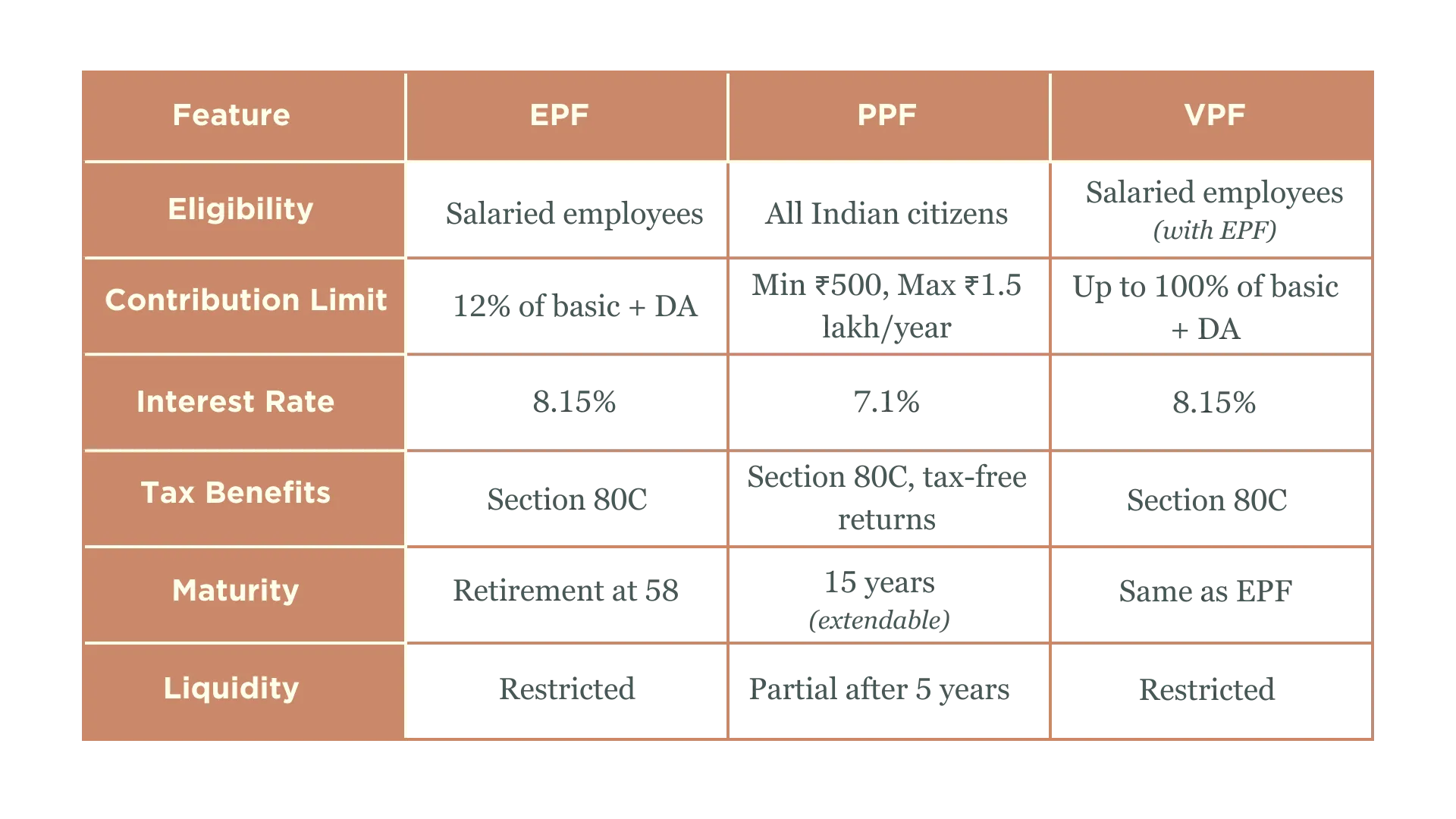When it comes to financial planning in India, selecting the right saving schemes can significantly impact long-term financial security. The Employee Provident Fund (EPF), Public Provident Fund (PPF), and Voluntary Provident Fund (VPF) are three common schemes. This article will walk you through each of them in detail, explaining how they differ, the benefits, and who they are best suited for. Let’s understand the essential distinctions between EPF, PPF, and VPF to help you make an informed decision based on your financial goals and employment status.
Employee Provident Fund (EPF)
The EPF is a compulsory savings scheme designed for salaried employees in India. Employers and employees both contribute towards this fund. Over time, the contributions accumulate, providing a lump sum retirement corpus along with interest.
Key Features of EPF
- Eligibility: Only salaried employees working for organisations registered under the EPF Act.
- Contribution: Both the employer and the employee contribute 12% of the employee’s salary (basic + DA).
- Tax Benefits: Contributions are eligible for tax deductions under Section 80C of the Income Tax Act.
- Interest Rate: The interest rate is determined by the government annually. For FY 2023–24, it stands at 8.15%.
- Liquidity: Withdrawals are possible only under certain conditions like retirement, medical emergencies, or purchasing a home.
- Maturity: The amount is accessible upon retirement at the age of 58 or in cases of unemployment after two months.
Public Provident Fund (PPF)
The PPF is a government-backed, long-term savings scheme that offers a safe investment avenue with attractive returns and tax benefits. It is suitable for both salaried and non-salaried individuals.
Key Features of PPF
- Eligibility: Any Indian citizen, including minors, can open a PPF account.
- Contribution: Minimum of ₹500 and a maximum of ₹1.5 lakh per financial year.
- Tax Benefits: PPF contributions are eligible for deductions under Section 80C. Moreover, interest earned and the maturity amount are entirely tax-free.
- Interest Rate: The government revises the interest rate quarterly. As of the latest update, it is 7.1%.
- Liquidity: Partial withdrawals are allowed after five years, and loans can be taken against the balance.
- Maturity: The tenure is 15 years, extendable in blocks of 5 years.
Voluntary Provident Fund (VPF)
The VPF is an extension of the EPF, allowing employees to voluntarily contribute more than the mandatory 12% towards their provident fund. This contribution is made from the employee’s salary, and employers are not obligated to match this contribution.
Key Features of VPF
- Eligibility: Only available to salaried employees who are already a part of the EPF scheme.
- Contribution: Employees can contribute up to 100% of their basic salary and dearness allowance.
- Tax Benefits: Contributions qualify for tax deductions under Section 80C. The interest earned is tax-free up to ₹2.5 lakh for non-government employees.
- Interest Rate: The same interest rate as the EPF, which is currently 8.15%.
- Liquidity: Similar to EPF, withdrawals are allowed under certain conditions.
- Maturity: VPF follows the same maturity rules as EPF, making it ideal for long-term wealth creation.
EPF vs PPF vs VPF at a Glance

Tax Implications After the 2024–25 Union Budget
The recent Union Budget brought several changes to the tax regime that affect retirement planning schemes like EPF, VPF, and PPF. Under the new tax regime, salaried individuals can benefit from increased standard deductions, and EPF remains a crucial tax-saving instrument.
New Tax Regime Slabs:
- Up to ₹3 lakh: Nil
- ₹3 lakh — ₹7 lakh: 5%
- ₹7 lakh — ₹10 lakh: 10%
- ₹10 lakh — ₹12 lakh: 15%
- ₹12 lakh — ₹15 lakh: 20%
- Above ₹15 lakh: 30%
How to Choose Between EPF, PPF, and VPF?
When deciding between EPF, PPF, and VPF, consider the following factors:
1. Employment Status
- EPF/VPF: Best suited for salaried individuals.
- PPF: Ideal for self-employed individuals and those in the unorganised sector.
2. Contribution Flexibility
- EPF/VPF: Contributions are tied to salary deductions.
- PPF: Offers flexibility in contribution amounts and timing, with a maximum limit of ₹1.5 lakh per year.
3. Employer Match
- EPF: Employers match the employee’s 12% contribution, enhancing retirement savings. This benefit is not available for PPF investors.
4. Lock-in Period and Withdrawal Rules
- PPF: Has a fixed 15-year lock-in period, but partial withdrawals are possible after five years.
- EPF/VPF: More restrictive but allows partial withdrawals for specific purposes.
5. Interest Rates and Risk Profile
- EPF and VPF offer a higher interest rate compared to PPF, but all three are government-backed, making them low-risk investments.
Conclusion
In conclusion, EPF, VPF, and PPF each provide valuable opportunities for building a secure retirement corpus, but the best choice depends on individual financial goals, risk tolerance, and employment status. While EPF and VPF offer higher returns for salaried employees, PPF serves as a more accessible option for those who are self-employed or from the unorganised sector. However, choosing the right investment is not just about understanding the schemes; it’s about knowing how to manage risk and create a proper financial strategy to align with your long-term objectives.
This is where selecting the right wealth management partner becomes essential. Dhanvesttor, a pioneering wealth management firm designed by women, for women, stands out as the perfect partner for such financial journeys. With a vision to create a women-inclusive financial ecosystem, Dhanvesttor empowers women to take control of their financial futures, maximising wealth opportunities while also developing finance-confident individuals. By choosing a trusted firm like Dhanvesttor, you can ensure that your wealth is managed strategically, with personalised solutions that cater to your unique financial goals, ultimately leading to a secure and prosperous retirement.



